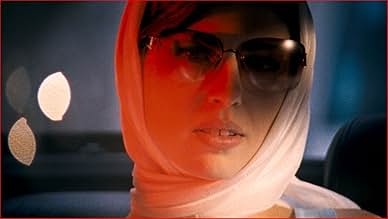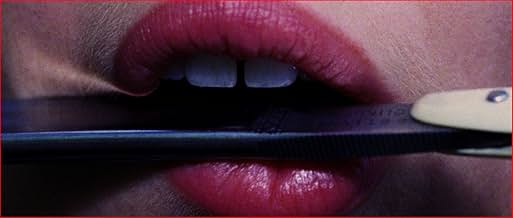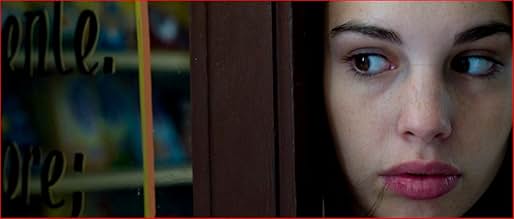IMDb-BEWERTUNG
6,1/10
6772
IHRE BEWERTUNG
Als junges Mädchen wurde Ana von Bildern des Todes und einer ominösen Gestalt in Schwarz gequält. Jetzt, als Erwachsene, wird sie erneut von schattenhaften, außerweltlichen Formen gequält.Als junges Mädchen wurde Ana von Bildern des Todes und einer ominösen Gestalt in Schwarz gequält. Jetzt, als Erwachsene, wird sie erneut von schattenhaften, außerweltlichen Formen gequält.Als junges Mädchen wurde Ana von Bildern des Todes und einer ominösen Gestalt in Schwarz gequält. Jetzt, als Erwachsene, wird sie erneut von schattenhaften, außerweltlichen Formen gequält.
- Regie
- Drehbuch
- Hauptbesetzung
- Auszeichnungen
- 7 Gewinne & 6 Nominierungen insgesamt
Charlotte Eugène Guibeaud
- Ana adolescente
- (as Charlotte Eugène Guibbaud)
Biancamaria D'Amato
- La mère
- (as Bianca Maria D'Amato)
Empfohlene Bewertungen
I have to agree with jan_ulalume's review in that this may be avant-guard to those who have never seen such imagery, but to those who have (in essence) grown up on this stuff, it is more akin to a "giallo's best hits".
With the "camera looking through the clear lightbulb shot" from SUSPIRIA (along with the colored lights directed onto people and key subject areas), Fulci's preoccupation with eyes and nose bridges, even encompassing Bava and countless other Italian filmographers filmic visual ques (WHO SAW HER DIE's funeral veil POV), like the former reviewer states it becomes over-saturation of style to the point of becoming ridiculous.
I will say that the first segment with the little girl is the best, simply due to the fact that there seems to be more of a coherent story that one can follow compared to the other two segments, which focus primarily on visuals alluding to some set of visual metaphors (even Zalman King wouldn't go this far), not to mention that the last segment's "twist" is (regardless of how predictable it may be to those familiar with these things) isn't built up very well at all.
Regardless, I would still suggest it (at least the blu-ray, as the clarity may help the viewing experience a bit) at least just to take it in. Maybe with some editing and some more giallo music (as the second and third acts are nearly music-less, which hurts those sections quite a bit for me) the movie could come across better...
With the "camera looking through the clear lightbulb shot" from SUSPIRIA (along with the colored lights directed onto people and key subject areas), Fulci's preoccupation with eyes and nose bridges, even encompassing Bava and countless other Italian filmographers filmic visual ques (WHO SAW HER DIE's funeral veil POV), like the former reviewer states it becomes over-saturation of style to the point of becoming ridiculous.
I will say that the first segment with the little girl is the best, simply due to the fact that there seems to be more of a coherent story that one can follow compared to the other two segments, which focus primarily on visuals alluding to some set of visual metaphors (even Zalman King wouldn't go this far), not to mention that the last segment's "twist" is (regardless of how predictable it may be to those familiar with these things) isn't built up very well at all.
Regardless, I would still suggest it (at least the blu-ray, as the clarity may help the viewing experience a bit) at least just to take it in. Maybe with some editing and some more giallo music (as the second and third acts are nearly music-less, which hurts those sections quite a bit for me) the movie could come across better...
Amer is an example of pure cinema if ever there was one. It's a movie with extremely little plot and very minimal dialogue. While on one level it's a homage to the Italian giallo film, it's at least equally an avant-garde experimental piece. If you could imagine a collision between Suspiria, A Lizard In A Woman's Skin and Meshes of the Afternoon you wouldn't be too far off the mark. It's similarity to the latter Maya Deren film is where it might be problematic to those who think they are in for a true homage to the giallo, as this is a movie that is more of a mood piece than anything else. Admittedly it's a pretty dark mood but nevertheless this is first and foremost an experimental work. Your tolerance level for narrative-free avant-garde cinema will be the deciding factor in whether you like this or not.
It's about a girl called Ana. And it's divided into three sections: childhood, adolescence and adulthood. The first part is the most impressive; it's a deeply creepy segment about the child at a highly traumatic moment in her life, involving her dead grandfather and her witnessing her parents having sex. It's full of surreal nightmare imagery that recalls some shots directly lifted from Suspiria, with the requisite intense colours – greens, blues, reds – with a creepy soundtrack of sighs that also recalls that famous old film. The second part loses the momentum a bit; it switches to a sunny outdoor locale and has the teenage Ana accompany her mother in a trip to the local town, where she seems to experience some sexual awakenings. The final part has Ana arriving at the run down family home again; this part incorporates some of the fetishistic giallo motifs that you might expect.
Amer is a highly stylised film. The cinematography is constantly inventive and artistic. There is a preponderance of close ups; in particular eyes and skin. The compositions are beautiful and the use of widescreen is excellent. When you see a film like this it does make you shake your head sadly when a film such as The King's Speech is nominated for best cinematography at the Oscars ceremony. As fine a film as it is the cinematography in that film, and most winners of this category in the Academy Awards, is solid yet so safe and unremarkable. This little film from Europe wins hands down against any contender from this year's Oscars in that category. But films like Amer are never nominated for Academy Awards and never will be. Rant over.
The film features a purely retro music soundtrack from the likes of Bruno Nicolai, Ennio Morricone and Stelvio Cipriani; the opening piece being from the Sergio Martino giallo film The Case of the Scorpion's Tail. And I suppose that opening would make you think this film is going to be a straight homage but as I have said it really isn't. Amer is most certainly not a film for everyone it has to be admitted but if you like gialli and avant-garde cinema then I think you would do well to at least give it a try.
It's about a girl called Ana. And it's divided into three sections: childhood, adolescence and adulthood. The first part is the most impressive; it's a deeply creepy segment about the child at a highly traumatic moment in her life, involving her dead grandfather and her witnessing her parents having sex. It's full of surreal nightmare imagery that recalls some shots directly lifted from Suspiria, with the requisite intense colours – greens, blues, reds – with a creepy soundtrack of sighs that also recalls that famous old film. The second part loses the momentum a bit; it switches to a sunny outdoor locale and has the teenage Ana accompany her mother in a trip to the local town, where she seems to experience some sexual awakenings. The final part has Ana arriving at the run down family home again; this part incorporates some of the fetishistic giallo motifs that you might expect.
Amer is a highly stylised film. The cinematography is constantly inventive and artistic. There is a preponderance of close ups; in particular eyes and skin. The compositions are beautiful and the use of widescreen is excellent. When you see a film like this it does make you shake your head sadly when a film such as The King's Speech is nominated for best cinematography at the Oscars ceremony. As fine a film as it is the cinematography in that film, and most winners of this category in the Academy Awards, is solid yet so safe and unremarkable. This little film from Europe wins hands down against any contender from this year's Oscars in that category. But films like Amer are never nominated for Academy Awards and never will be. Rant over.
The film features a purely retro music soundtrack from the likes of Bruno Nicolai, Ennio Morricone and Stelvio Cipriani; the opening piece being from the Sergio Martino giallo film The Case of the Scorpion's Tail. And I suppose that opening would make you think this film is going to be a straight homage but as I have said it really isn't. Amer is most certainly not a film for everyone it has to be admitted but if you like gialli and avant-garde cinema then I think you would do well to at least give it a try.
Act 1 is brilliant - a terrifying, sensual, nightmarish homage to Dario Argento. Act 2 is boring filler. Act 3 has a nasty torture scene and is better than the second act, but still feels pointless.
When I included Amer in a short list of films I was eagerly anticipating in 2010, I wrote that I was looking forward to "ostentatious cameras that go on a discovery of psychosexual nightmares, a stylish violence, jazzy grooves". I'm a big fan of Italian genre cinema, especially gialli, for me they fulfill the needs comic-books do in others. When I say I'm a fan, I mean that when Stelvio Cipriani's song La Polizia Ha Le Mani Legate (originally part of Cipriani's score for Roma Violenta) finished playing in Amer's end credits, I rummaged through my cd collection to find it.
But, even as I was writing that a few months ago, Amer already had a reputation as more than a giallo film, "arthouse" people insisted, which intrigued me more. So, does Amer reward the giallo fan with the wink of film reference, or is the giallo only the trope of an expression intended for a different audience?
To go back to my appreciation for the giallo as comic book, it's the mentality of the colorful panel that appeals to me, the vivid bits of casual violence to strike a chord and be forgotten after the next page, the indulgence on something that reaches only as deep as the excitement it provides. To put so much effort or go through all the trouble for the pleasure of something momentary, this exaggeration is essentially the province of youth, where the fling of a few days burns with the passion of true love. In this sense, the giallo rejuvenates me.
That in mind, Amer is at once an apotheosis and a keelhaul of the panel, an overkill of shots capturing small details, of closeups of eyes or reflections or bits of the human anatomy. It's a world come alive through the senses, by a child overhearing conversations from behind closed doors, or a young girl feeling the first tingling of a booming sexuality in her skin. There's very little dialogue and this appeals to me, because the convoluted plots were always my least favorite aspect of the giallo.
But if Amer is not pushed forward by people talking, does it establish other means of communicating this story of sexual awakening and repression, the schism that follows from a child discovering a cruel world or a teenager being denied that discovery on her own?
I'll say yes, but with reservations. Still, what's important for me, is the tweaking of the filmed image to see is there another way to make cinema, the nature of an experiment whose results can only be appreciated in the future. Better said, if we peel a cabbage we get the core, but if we peel an onion? Some will say we get nothing, but we've done the peeling and we've transformed the onion, so can we really say that? The cinema of Amer is that peeling.
Two things particularly stand out for me here in this cinematic depiction of trauma.
One is the root of it, seen through the kaleidoscope of a child's awestruck imagination. A child's feverish nightmare shot in the otherworldly cyans and magentas of Mario Bava, where disfigured old men and strange hooded figures reach out to the camera. This is probably the most horrific part of the movie.
The other is the cause and effect of the teenage girl's sexual awakening. The directors explore this with a marvellous sense of exaggeration, of a complete fetishization of sexuality and the human body. When the young girl comes across a group of bikers, we get blurry closeups of chrome, of throats undulating or the trickle of perspiration, of buckles and boots. The girl approaches them almost solemnly, clinging to her short summer dress, with an air of fearful apprehension and the irrepressible instinct of a moth drawn to a flame. Before her discovery can be consumated, her overbearing mother shows up to slap her for the offense and take her away. Simple, crude some may say, but brilliant in getting a point across.
It's in the film's conclusion that we find the giallo lurking in the shadows of a ruined mansion, where the black-gloved hand of the killer slashes the dark. The directors give us the killing hand but with a twist, another contraption of the giallo.
What about the intended audience though? I feel that Amer will appeal more to fans of the sexual psychodrama of Repulsion, than the fan who will seek out a film like Amuck for the profound pleasure of watching giallo queens Barbara Bouchet and Rosalba Neri make out on the same bed. The lurid tradition of Sergio Martino is only honored in the selection of epochal musis by the likes of Bruno Nicolai, Morricone or Cipriani.
But, even as I was writing that a few months ago, Amer already had a reputation as more than a giallo film, "arthouse" people insisted, which intrigued me more. So, does Amer reward the giallo fan with the wink of film reference, or is the giallo only the trope of an expression intended for a different audience?
To go back to my appreciation for the giallo as comic book, it's the mentality of the colorful panel that appeals to me, the vivid bits of casual violence to strike a chord and be forgotten after the next page, the indulgence on something that reaches only as deep as the excitement it provides. To put so much effort or go through all the trouble for the pleasure of something momentary, this exaggeration is essentially the province of youth, where the fling of a few days burns with the passion of true love. In this sense, the giallo rejuvenates me.
That in mind, Amer is at once an apotheosis and a keelhaul of the panel, an overkill of shots capturing small details, of closeups of eyes or reflections or bits of the human anatomy. It's a world come alive through the senses, by a child overhearing conversations from behind closed doors, or a young girl feeling the first tingling of a booming sexuality in her skin. There's very little dialogue and this appeals to me, because the convoluted plots were always my least favorite aspect of the giallo.
But if Amer is not pushed forward by people talking, does it establish other means of communicating this story of sexual awakening and repression, the schism that follows from a child discovering a cruel world or a teenager being denied that discovery on her own?
I'll say yes, but with reservations. Still, what's important for me, is the tweaking of the filmed image to see is there another way to make cinema, the nature of an experiment whose results can only be appreciated in the future. Better said, if we peel a cabbage we get the core, but if we peel an onion? Some will say we get nothing, but we've done the peeling and we've transformed the onion, so can we really say that? The cinema of Amer is that peeling.
Two things particularly stand out for me here in this cinematic depiction of trauma.
One is the root of it, seen through the kaleidoscope of a child's awestruck imagination. A child's feverish nightmare shot in the otherworldly cyans and magentas of Mario Bava, where disfigured old men and strange hooded figures reach out to the camera. This is probably the most horrific part of the movie.
The other is the cause and effect of the teenage girl's sexual awakening. The directors explore this with a marvellous sense of exaggeration, of a complete fetishization of sexuality and the human body. When the young girl comes across a group of bikers, we get blurry closeups of chrome, of throats undulating or the trickle of perspiration, of buckles and boots. The girl approaches them almost solemnly, clinging to her short summer dress, with an air of fearful apprehension and the irrepressible instinct of a moth drawn to a flame. Before her discovery can be consumated, her overbearing mother shows up to slap her for the offense and take her away. Simple, crude some may say, but brilliant in getting a point across.
It's in the film's conclusion that we find the giallo lurking in the shadows of a ruined mansion, where the black-gloved hand of the killer slashes the dark. The directors give us the killing hand but with a twist, another contraption of the giallo.
What about the intended audience though? I feel that Amer will appeal more to fans of the sexual psychodrama of Repulsion, than the fan who will seek out a film like Amuck for the profound pleasure of watching giallo queens Barbara Bouchet and Rosalba Neri make out on the same bed. The lurid tradition of Sergio Martino is only honored in the selection of epochal musis by the likes of Bruno Nicolai, Morricone or Cipriani.
The NY TIMES called AMER "an exercise in giallo (eroticized horror), a richly colorful mosaic of sinister sidelong glances" while the LA TIMES enthused, "a nightmare vision of desire and fear -gorgeous, heady, dazzling!" but these pointed paeans are only partly true. Except for the odd snippet, there's no dialog or musical score in the three vignettes depicting the life of a disturbed young woman (childhood, adolescence, adulthood) and although the last sequence contains elements of the giallo, the film is more of an homage to the indelible images of "maestro of the macabre" Mario Bava.
AMER's first segment on a child's reaction to her grandfather's death re-imagines the opening tale in Bava's trilogy I TRE VOLTE DELLA PAURA (aka BLACK SABBATH) from prying a valuable object out of a dead man's hand and the nightmare that follows right down to the dripping water and eerie blue, green, and red light that bathed the terrifying tableaux. The second segment on the girl's dangerous sexual awakening combines Bava's OPERAZIONE PAURA (aka KILL BABY KILL) and it's white soccer ball with the nebulous evil-under-the-sun aura of Tennesse Williams' SUDDENLY LAST SUMMER. The third and final scene that sees the young woman revisiting the abandoned villa where she grew up actually does reference BLOOD & BLACK LACE-style gialli with its black gloves, straight razor, and stalking sequence that leads up to a graphic murder. Unfortunately, there's only one (barely set piece) slaying in AMER and this dreamy collage of jump cuts, split screens, and undeniably beautiful imagery is less than the sum of its parts which may prove disappointing to hard-core horror fans. Cineastes -and those who enjoy avant-garde narrative as well as color-drenched kaleidoscopic visuals- should, however, get their money's worth. Hélène Cattet & Bruno Forzani's offbeat endeavor also reeks of Roman Polanski's REPULSION and I found the "eroticized" exercise admirable but more dull than anything else.
AMER's first segment on a child's reaction to her grandfather's death re-imagines the opening tale in Bava's trilogy I TRE VOLTE DELLA PAURA (aka BLACK SABBATH) from prying a valuable object out of a dead man's hand and the nightmare that follows right down to the dripping water and eerie blue, green, and red light that bathed the terrifying tableaux. The second segment on the girl's dangerous sexual awakening combines Bava's OPERAZIONE PAURA (aka KILL BABY KILL) and it's white soccer ball with the nebulous evil-under-the-sun aura of Tennesse Williams' SUDDENLY LAST SUMMER. The third and final scene that sees the young woman revisiting the abandoned villa where she grew up actually does reference BLOOD & BLACK LACE-style gialli with its black gloves, straight razor, and stalking sequence that leads up to a graphic murder. Unfortunately, there's only one (barely set piece) slaying in AMER and this dreamy collage of jump cuts, split screens, and undeniably beautiful imagery is less than the sum of its parts which may prove disappointing to hard-core horror fans. Cineastes -and those who enjoy avant-garde narrative as well as color-drenched kaleidoscopic visuals- should, however, get their money's worth. Hélène Cattet & Bruno Forzani's offbeat endeavor also reeks of Roman Polanski's REPULSION and I found the "eroticized" exercise admirable but more dull than anything else.
Wusstest du schon
- WissenswertesShot on 16mm film and then blown up to 35mm to recreate the grainy effect of 1970s exploitation movies.
- VerbindungenReferenced in Lost in Vienna, Austria (2013)
Top-Auswahl
Melde dich zum Bewerten an und greife auf die Watchlist für personalisierte Empfehlungen zu.
- How long is Amer?Powered by Alexa
Details
- Erscheinungsdatum
- Herkunftsländer
- Offizieller Standort
- Sprache
- Auch bekannt als
- Amer - ein Albtraum aus Angst und Begierde
- Drehorte
- Produktionsfirmen
- Weitere beteiligte Unternehmen bei IMDbPro anzeigen
Box Office
- Budget
- 880.000 € (geschätzt)
- Laufzeit1 Stunde 30 Minuten
- Farbe
- Sound-Mix
- Seitenverhältnis
- 2.35 : 1
Zu dieser Seite beitragen
Bearbeitung vorschlagen oder fehlenden Inhalt hinzufügen





















